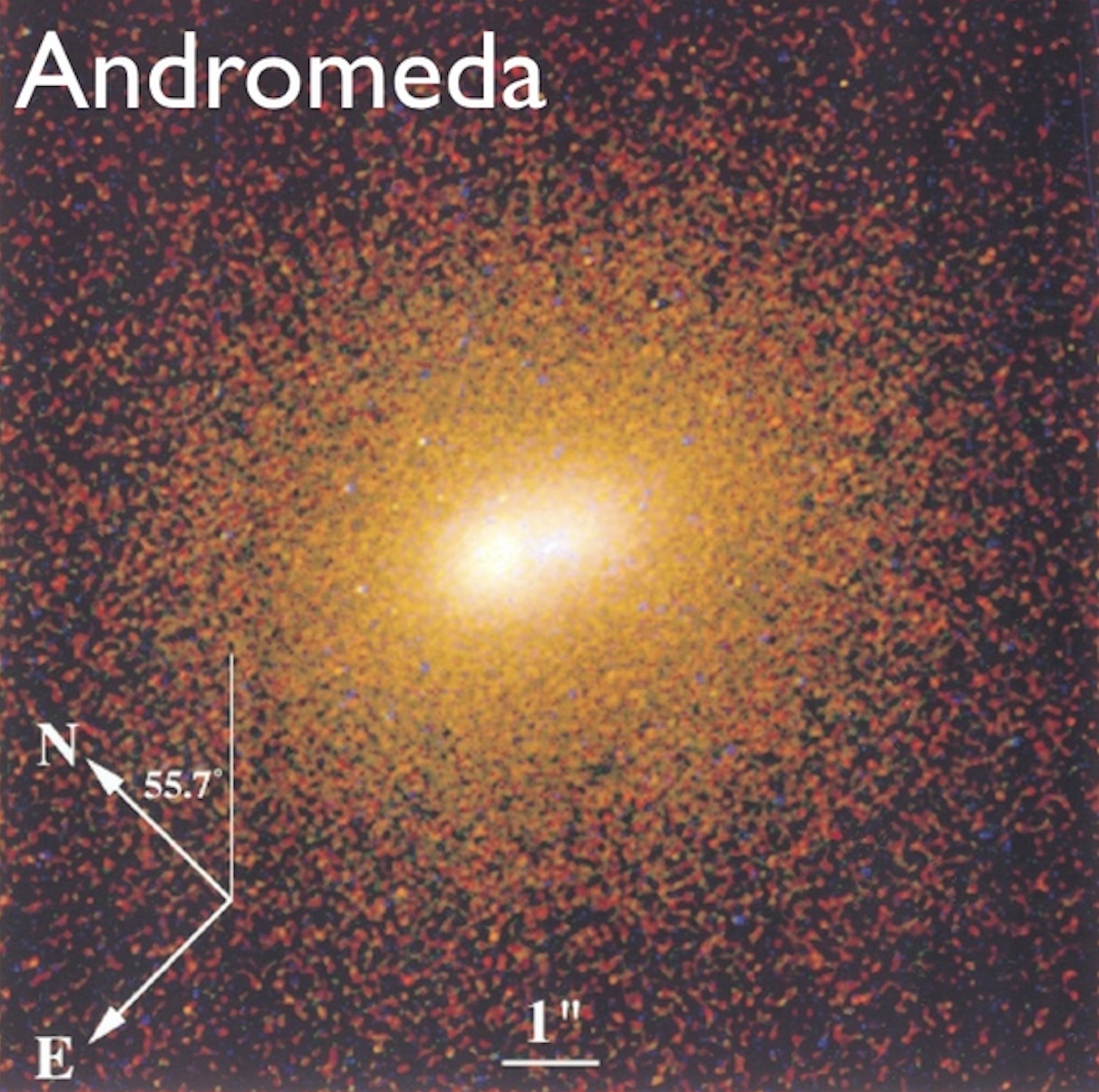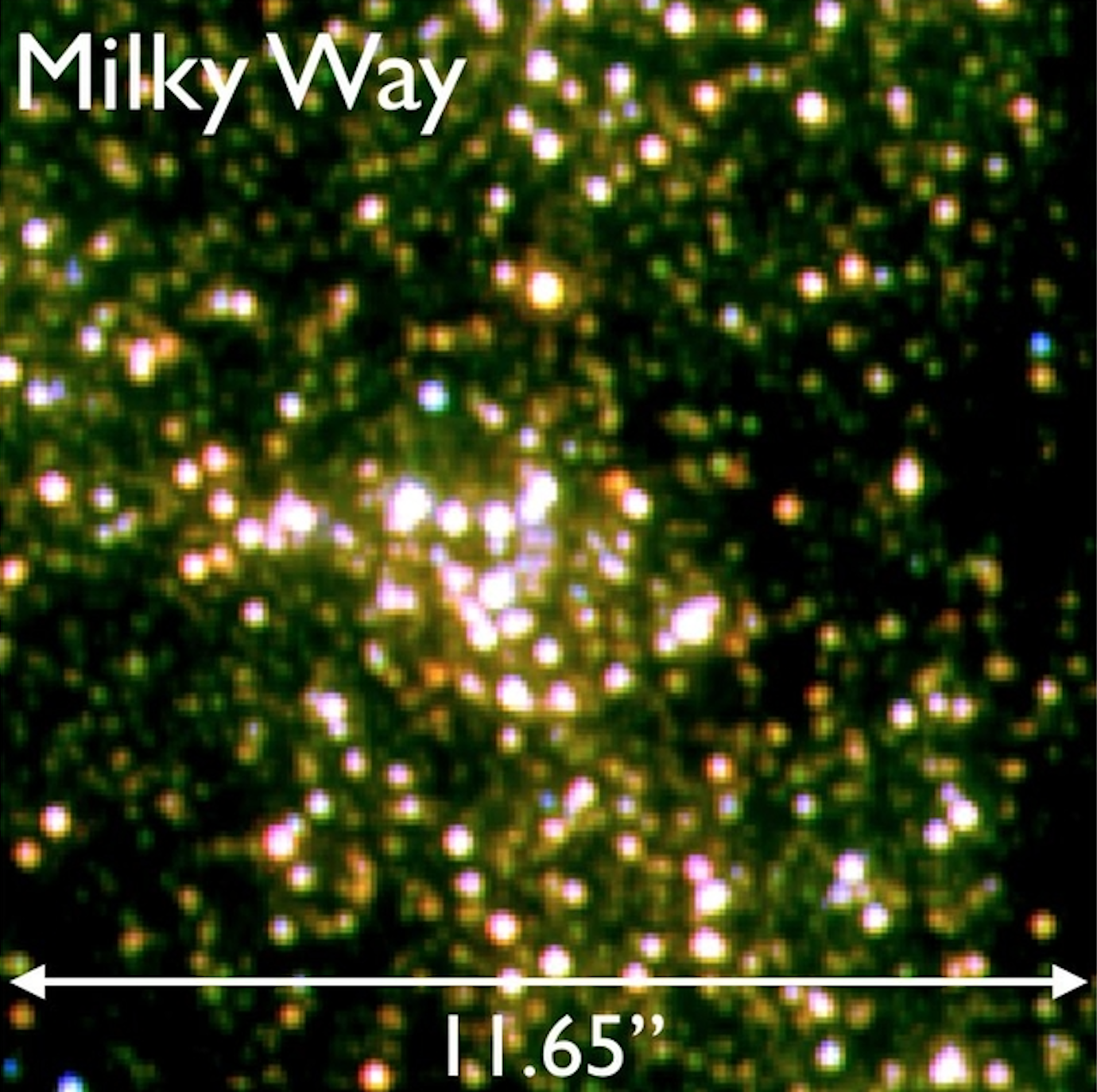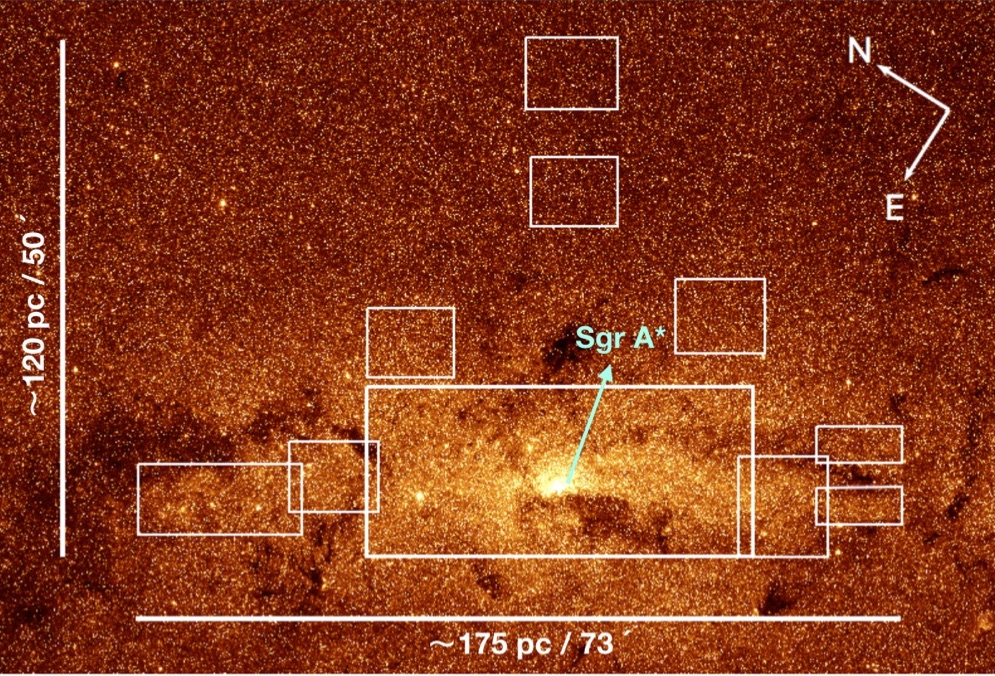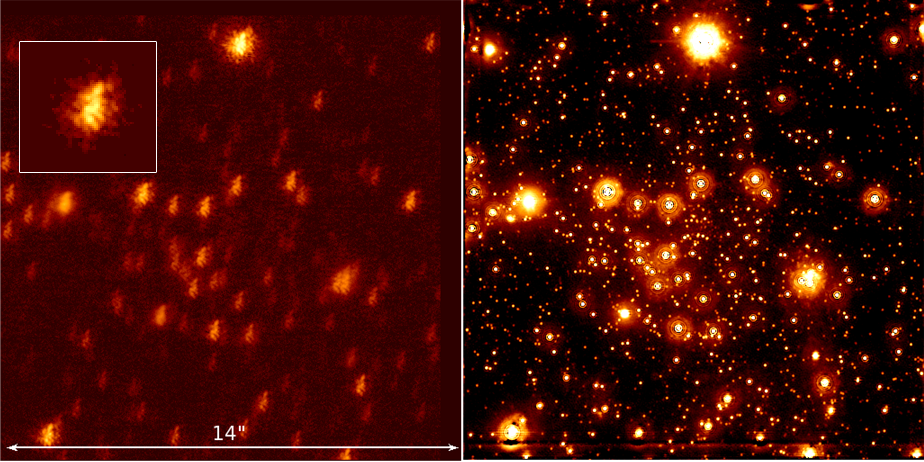The goal of the project is to provide a breakthrough in our knowledge of the stellar structures and stellar populations around the massive black hole at the heart of the Milky Way.
The Galactic Centre: A Unique Astrophysical Laboratory
Galactic nuclei are the dense inner cores of galaxies, where stellar densities can reach values over a million times the one in the Sun´s neighbourhood. In galaxies similar to our Milky Way the nucleus is dominated by a massive black hole, with a mass between a hundred thousand to a few ten million solar masses, surrounded by a nuclear star cluster of a few hundred thousand to a few tens of million solar masses. To explore these environments adequately, we need images and spectroscopy with the highest possible angular resolution. With the currently existing biggest ground-based telescopes (8-10m primary mirrors) we can reach angular resolutions of the order 0.05”. This corresponds to a physical scale of 0.002 pc in the centre of our own Galaxy, but already to 0.2 pc in the case of the Andromeda galaxy, the nearest galaxy similar to the Milky Way. Assuming a modest surface density of one million stars per square parsec, one resolution element thus comprises roughly a few stars in the Galactic Centre (GC), but a few tens of thousands of stars in Andromeda´s nucleus. This simple back-of-the-envelope estimate demonstrates in an impressive way that the centre of the Milky Way is a unique place in the Universe where we can explore the interaction between stars, interstellar medium and a massive black hole.


The left panel shows a UVI image of the nucleus of the Andromeda Galaxy (M31) with WFPC2/Hubble Space Telescope (HST). The right panel shows a pseudo-colour near-infrared image of the nucleus of the Milky Way with WFC3/HST. Both images have exactly the same size of 11.65" on each side. This corresponds to a physical length scale of 45 pc in case of the Andromeda galaxy, but of only 0.45 pc in case of the Milky Way, where we can discern hundreds of stars.
GALACTICNUCLEUS survey
The Fingerprint of a Galactic Nucleus
The GALACTICNUCLEUS survey fills this blind spot on the sky. To overcome the challenge to image large fields from the ground at high angular resolution and with a homogeneous image quality, we use an adapted speckle holography algorithm. The observations were acquired in the frame of a 160 hour ESO (Europea Southern Observatory) Large Programme with the near-infrared imager HAWK-I at the VLT (LP 195.B-0283; PI: Schödel).

GALACTICNUCLEUS provides 0.2” angular resolution images in three near-infrared filters (JHKs) for a region of 0.3 square degrees or 6000 pc2 for the central area of the Milky Way’s nuclear stellar disk. Because of the high angular resolution, GALACTIC NUCLEUS is about 10 times less confused than any other existing multi-wavelength survey of the region. The first release of the GALACTICNUCLEUS catalogue contains about 3 million stars and can be accessed via the ESO's archive facility. The ESO archive also offers access to all reduced GALACTICNUCLEUS images.
RGB colour images of the individual fields of GALACTICNUCLEUS can be downloaded from our website.

The survey fields are superposed on a Spitzer 3.6 µm image of the Galactic Centre region (Stolovy et al. 1996).
Key to obtaining accurate photometry of the stars in the Galactic Centre is the use of an angular resolution as high as possible. For this purpose we apply the speckle holography algorithm (see, e.g., Primot et al. 1990, Petr et al. 1998, Schödel et al. 2013, and references therein). Please see Methodology section for more information.
Results
The following work cites the GALACTICNUCLEUS survey (GALACTICNUCLEUS citations).
Publications of our group based on GALACTICNUCLEUS:
- A KMOS survey of the nuclear disk of the Milky Way. I. Survey design and metallicities, Fritz, T. K., Patrick, L. R., Feldmeier-Krause, A., Schödel, R., Schultheis, M., Gerhard, O., Nandakumar, G., Neumayer, N., Nogueras-Lara, F., and Prieto, M. A. 2021,A&A,649,A83
- Distance to three molecular clouds in the central molecular zone, Nogueras-Lara, F., Schödel, R., Neumayer, N., and Schultheis, M. 2021,A&A,647,L6
- Jeans modelling of the Milky Way's nuclear stellar disc, Sormani, M. C., Magorrian, J., Nogueras-Lara, F., Neumayer, N., Schönrich, R., Klessen, R. S., and Mastrobuono-Battisti, A. 2020,MNRAS,499,7
- GALACTICNUCLEUS: A high angular-resolution JHKs imaging survey of the Galactic centre. III. Evidence for wavelength-dependence of the extinction curve in the near-infrared, Nogueras-Lara, F., Schödel, R., Neumayer, N., Gallego-Cano, E., Shahzamanian, B., Gallego-Calvente, A. T., and Najarro, F. 2020,A&A,641,A141
- GALACTICNUCLEUS: A high angular-resolution JHKs imaging survey of the Galactic centre. III. Evidence for wavelength-dependence of the extinction curve in the near-infrared, Nogueras-Lara, F., Schödel, R., Neumayer, N., Gallego-Cano, E., Shahzamanian, B., Gallego-Calvente, A. T., and Najarro, F. 2020,A&A,641,A141
- Detailed Abundances in the Galactic Center: Evidence of a Metal-rich Alpha-enhanced Stellar Population, Thorsbro, B., Ryde, N., Rich, R. M., Schultheis, M., Renaud, F., Spitoni, E., Fritz, T. K., Mastrobuono-Battisti, A., Origlia, L., Matteucci, F., and Schödel, R. 2020,ApJ,894,26
- New constraints on the structure of the nuclear stellar cluster of the Milky Way from star counts and MIR imaging, Gallego-Cano, E., Schödel, R., Nogueras-Lara, F., Dong, H., Shahzamanian, B., Fritz, T. K., Gallego-Calvente, A. T., and Neumayer, N. 2020,A&A,634,A71
- Early formation and recent starburst activity in the nuclear disk of the Milky Way, Nogueras-Lara, F., Schödel, R., Gallego-Calvente, A. T., Gallego-Cano, E., Shahzamanian, B., Dong, H., Neumayer, N., Hilker, M., Najarro, F., Nishiyama, S., Feldmeier-Krause, A., Girard, J. H. V., and Cassisi, S. 2020,NatAs,4,377
- First results from a large-scale proper motion study of the Galactic centre, Shahzamanian, B., Schödel, R., Nogueras-Lara, F., Dong, H., Gallego-Cano, E., Gallego-Calvente, A. T., and Gardini, A. 2019,A&A,632,A116
- GALACTICNUCLEUS: A high-angular-resolution JHKs imaging survey of the Galactic centre. II. First data release of the catalogue and the most detailed CMDs of the GC, Nogueras-Lara, F., Schödel, R., Gallego-Calvente, A. T., Dong, H., Gallego-Cano, E., Shahzamanian, B., Girard, J. H. V., Nishiyama, S., Najarro, F., and Neumayer, N. 2019,A&A,631,A20
- Star formation history and metallicity in the Galactic inner bulge revealed by the red giant branch bump, Nogueras-Lara, F., Schödel, R., Dong, H., Najarro, F., Gallego-Calvente, A. T., Hilker, M., Gallego-Cano, E., Nishiyama, S., Neumayer, N., Feldmeier-Krause, A., Girard, J. H. V., Cassisi, S., and Pietrinferni, A. 2018,A&A,620,A83
- GALACTICNUCLEUS: A high angular resolution JHKs imaging survey of the Galactic centre. I. Methodology, performance, and near-infrared extinction towards the Galactic centre, Nogueras-Lara, F., Gallego-Calvente, A. T., Dong, H., Gallego-Cano, E., Girard, J. H. V., Hilker, M., de Zeeuw, P. T., Feldmeier-Krause, A., Nishiyama, S., Najarro, F., Neumayer, N., and Schödel, R. 2018,A&A,610,A83
Methodology: Speckle Holography

To obtain the necessary series of short exposures, we use HAWK-I/VLT in its FASTJITTER mode with an exposure time of 1.2s. This short exposure time forces us to window the detector so that we can only use 1/3 of HAWK-Is field-of-view, corresponding to about 7.5’x3’. The picture above shows a comparison between a field in the Galactic Centre as imaged with WFC3 at the Hubble Space Telescope (HST) and with HAWK-I at the VLT. As we can see, we can obtain data of equivalent angular resolution. The advantage of the HST is a more stable PSF and sensitivity than in our ground-based observations. HAWK-I/VLT, on the other hand, provides us with a much larger instrumental field-of-view, easier access to the observatory, and the possibility to perform observations in the K-band (~2.2 µm), which is crucial to correctly estimate the interstellar extinction in this field.

Funding
European Research Council (ERC)
Grant agreement no.: 614922
February 2014 - October 2019
PI: Rainer Schödel
